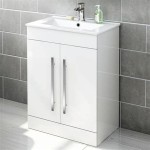How To Increase Hot Water Pressure In Bathroom Sink
When trying to enjoy a comfortable shower, washing your hands, or cleaning, low hot water pressure can be a frustrating issue. If you're facing this problem in your bathroom sink, there are several practical steps you can take to resolve it and restore adequate water pressure.
1. Check the Aerator
The aerator, a small device attached to the tip of the faucet, can become clogged with mineral deposits or debris over time, restricting water flow. Remove the aerator using a wrench or pliers, clean it thoroughly with vinegar or a descaling solution, and reattach it to the faucet. This simple step can often restore water pressure.
2. Inspect the Faucet Cartridge
A worn-out or faulty faucet cartridge can also impede water flow. To replace the cartridge, shut off the water supply, remove the handle, and unscrew the cartridge using a cartridge puller or adjustable wrench. Install a new cartridge, tighten it securely, and reassemble the faucet.
3. Clean the Water Supply Lines
Mineral buildup or sediment in the water supply lines can restrict water flow to the bathroom sink. Locate the shut-off valves for the hot water supply and detach the lines from the faucet. Use a wire brush or pipe cleaner to remove any visible debris, then reconnect the lines and turn on the water supply to flush out any remaining sediment.
4. Adjust the Pressure Regulator
A pressure regulator, typically located near the water meter or main water supply, helps control water pressure throughout the house. If the pressure regulator is set too low, it can limit the flow of hot water to the bathroom sink. Adjust the pressure regulator by turning the adjustment screw clockwise to increase pressure. However, do not exceed the recommended pressure limit for your plumbing system.
5. Check the Hot Water Heater
If the hot water pressure is low throughout the house and not just in the bathroom sink, it could indicate an issue with the hot water heater. Ensure that the heater is functioning properly and that the temperature is set high enough (typically between 120°F and 140°F). If the heater is old or malfunctioning, it may need to be repaired or replaced.
6. Inspect the Showerhead or Bathtub Spout
In some cases, low hot water pressure in the bathroom sink can be caused by a clogged showerhead or bathtub spout. Remove the showerhead or spout and clean it thoroughly with vinegar or a descaling solution to remove mineral deposits or debris. Reinstall the showerhead or spout and check if the water pressure has improved.
7. Contact a Plumber
If you have tried all the above steps and still have low hot water pressure in the bathroom sink, it is advisable to contact a licensed plumber. A professional plumber can diagnose the underlying cause of the issue and recommend the most appropriate solution, whether it's replacing a faulty component, repairing a leak, or adjusting the water pressure settings.

Low Water Pressure In Bathroom Sink 4 Reasons And 8 Fixes Bargain

Low Water Pressure In Bathroom Sink 4 Reasons And 8 Fixes Bargain

How To Fix Low Water Pressure In Faucet

How To Fix Low Water Pressure In A Faucet

How To Fix Low Water Pressure In Faucet

4 Ways To Adjust Faucet Water Pressure Wikihow

What Causes Low Water Pressure In Bathroom Sink 5 Ways To Fix It November 2024

4 Ways To Adjust Faucet Water Pressure Wikihow

Easy Fix For Low Water Pressure In Kitchen Sink Or Bathroom

What Causes Low Water Pressure In Bathroom Sink 5 Ways To Fix It November 2024
Related Posts







